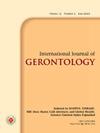筛选工具作为识别日本老年人依赖风险的主观措施的效果:客观和主观措施之间的多元回归分析
IF 0.3
4区 医学
Q4 GERIATRICS & GERONTOLOGY
引用次数: 1
摘要
背景:在老年人的流行病学和安全性方面,自我报告的日常生活活动问卷即筛查工具往往被用作主观测量,而客观测量通过直接观察提供了具体的定量的身体功能信息,而不考虑年龄。我们的目的是澄清日本使用的老年人依赖风险筛查工具(SRD)作为主观测量是否可以预测老年人身体功能的客观测量。方法:对81名60岁及以上的社区老年人进行研究。他们完成了SRD作为主观测量,并进行了物理性能电池(PPB)作为客观测量。对SRD与PPB的关系进行统计学探讨。结果:SRD与PPB的四个结构域之一有显著相关性;全身运动能力,F(4,73) = 8.04, p < 0.001。SRD的显著预测因子为跌倒经历(β = 0.25, t = 2.42, p = 0.018)和跌倒焦虑(β = 0.24, t = 2.27, p = 0.026)。显著回归模型解释了23%的关联。结论:SRD的两个问题可以预测老年人全身运动的客观指标。SRD需要修改,以确保日常生活活动的各个方面,不仅是运动,还包括姿势的改变,上肢的操作和手的灵巧性。自我报告的问卷可以用来识别有依赖风险的老年人,只要有适当的问题。本文章由计算机程序翻译,如有差异,请以英文原文为准。
Effect of Screening Tool as Subjective Measure to Identify Older Adults at Risk of Dependency in Japan: Multivariate Regression Analysis between Objective and Subjective Measures
Background: In terms of epidemiology and safety for older adults, self-reported questionnaires on activities of daily living, that is, screening tools are often applied as subjective measures, though objective measures provide concrete quantitative information of physical function through direct observation regardless of age. We aimed to clarify whether or not the screening tool for older adults at risk of dependency (SRD) utilized in Japan as subjective measures could predict objective measures on physical function among older adults. Methods: The study was conducted with 81 community-dwelling older adults aged 60 years and over. They completed SRD as subjective measures and underwent physical performance battery (PPB) as objective measures. The association between SRD and PPB was statistically explored. Results: SRD was significantly associated with one of the four domains in PPB; locomotion of the whole body, F(4, 73) = 8.04, p < .001. The significant predictors were falling experience, β = 0.25, t = 2.42, p = .018, and falling anxiety, β = 0.24, t = 2.27, p = .026, in SRD. The significant regression models explained 23% of the association. Conclusions: The two questions of SRD could predict objective measures on locomotion of the whole body among older adults. SRD needs to be revised to ensure every aspect of activities of daily living, not only locomotion, also change of posture, manipulation of the upper limb, and manual dexterity. Self-reported questionnaires can be utilized to identify older adults at risk of dependency, only if with appropriate questions.
求助全文
通过发布文献求助,成功后即可免费获取论文全文。
去求助
来源期刊
CiteScore
0.60
自引率
0.00%
发文量
0
审稿时长
6-12 weeks
期刊介绍:
The Journal aims to publish original research and review papers on all fields of geriatrics and gerontology, including those dealing with critical care and emergency medicine.
The IJGE aims to explore and clarify the medical science and philosophy in all fields of geriatrics and gerontology, including those in the emergency and critical care medicine. The IJGE is determined not only to be a professional journal in gerontology, but also a leading source of information for the developing field of geriatric emergency and critical care medicine. It is a pioneer in Asia.
Topics in the IJGE cover the advancement of diagnosis and management in urgent, serious and chronic intractable diseases in later life, preventive medicine, long-term care of disability, ethical issues in the diseased elderly and biochemistry, cell biology, endocrinology, molecular biology, pharmacology, physiology and protein chemistry involving diseases associated with age. We did not limit the territory to only critical or emergency condition inasmuch as chronic diseases are frequently brought about by inappropriate management of acute problems.

 求助内容:
求助内容: 应助结果提醒方式:
应助结果提醒方式:


